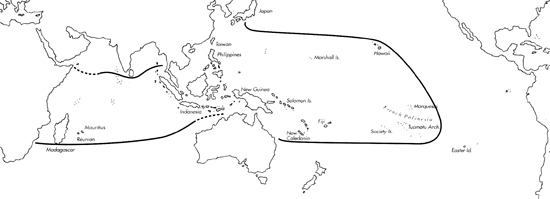Range: E. Africa to Tuamotu Archipelago and Hawaii.
Description: Medium-sized to moderately large, moderately solid to solid. Last whorl narrowly ovate or narrowly cylindrical to narrowly conoid-cylindrical; outline slightly convex to straight and parallel-sided at adapical two-thirds, straight to slightly concave below. Aperture wider near base than at shoulder. Shoulder rounded to subangulate. Spire of moderate height, outline usually sigmoid. Larval shell of about 3.25 whorls, maximum diameter about 0.8 mm. First 4-5 postnuclear whorls tuberculate. Teleoconch sutural ramps slightly concave to slightly convex within the same specimen, with 1 increasing to 3-5 spiral grooves, usually weaker or sometimes replaced by many spiral striae on latest ramps. Last whorl with fine, closely spaced spiral ribs from base to shoulder; sculpture sometimes weak.
| Shell Morphometry | ||
|---|---|---|
| L | 40-69 mm | |
| RW | 0.10-0.31 g/mm | |
| (L 40-65 mm) | ||
| RD | 0.40-0.46 | |
| PMD | 0.69-0.78 | |
| RSH | 0.12-0.18 | |
Ground colour white, suffused with rose in specimens from Tuamotu Archipelago. Last whorl overlaid with brown leaving numerous very small (Indian Ocean shells) to medium-sized (Pacific shells) ground-colour tents, edged with brown lines at frontal sides and arranged in 2-4 spiral bands. Brown zones usually with darker brown spiral lines sometimes articulated with ground-colour dots and tents. Larval whorls white to cream. First 3-4 postnuclear sutural ramps immaculate, white to cream or pale pink. Following sutural ramps matching last whorl in colour pattern. Aperture usually white.
Periostracum yellow-brown, thin, translucent, smooth.
Dorsum of foot white, mottled with brown, mottling denser and darker marginally; anterior part with 3 black blotches in a clover-leaf arrangement; posterior end with 2 lateral black blotches. Sole of foot white, sparsely dotted with brown. Rostrum white to brownish cream. Tentacles white, tipped with light and darker brown. Siphon white, grading to reddish brown distally, with a broad black ring centrally, and mottled with brown proximally (Pearson, unpubl. observ.) (Pl. 84, Third row, right).
Habitat and Habits: In 3-40 m; on coral reefs, on sand slopes, in sand pockets and in caves.
Discussion: C. auricomus is similar to C. aulicus form gracianus, C. auratinus and C. aureus aureus. C. aulicus form gracianus differs in its straight to slightly concave spire outline, less prominent spiral sculpture on the late sutural ramps and on the last whorl, and its more convex sided last whorl. C. auratinus attains larger size and has a generally broader last whorl, the position of its maximum diameter is distinctly closer to the base (PMD 0.56-0.65), its spire outline is straight, and its spire sculpture is less prominent. C. aureus aureus can be distinguished by its broader last whorl (RD 0.46-0.53), straight-sided rather than domed early spire whorls, and by its last whorl pattern with broad, blackish brown axial lines. Indian Ocean shells of C. auricomus have a finer recticulate pattern than Pacific shells. C. dactylosus and C. debilis refer to specimens with such fine networks.

C. auricomus range map
This section contains verbatim reproductions of the accounts of 316 species of Conus from the Indo-Pacific region, from Manual of the Living Conidae, by Röckel, Korn and Kohn (1995). They are reproduced with the kind permission of the present publisher, Conchbooks.
All plates and figures referred to in the text are also in Röckel, Korn & Kohn, 1995. Manual of the Living Conidae Vol. 1: Indo-Pacific Region.
The range maps have been modified so that each species account has it own map, rather than one map that showed the ranges of several species in the original work. This was necessary because each species account is on a separate page on the website and not confined to the order of accounts in the book.